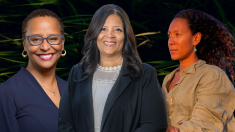Janelle Monáe inspires herself.
This is not to say that she’s an egoist or that she doesn’t take inspiration from life and objects around her. But it is to say that in her own struggle to complete a painting and to name the colorful woman depicted, she wound up penning an album. And not just a regular ole two-major-hits album, The Electric Lady offers 12 tracks of great listens.
Under Big Boi’s esoteric tutelage, she’s had several well-received projects; however, this is the one that will probably launch Monáe, 27, from underground indie-cool popularity to NBA Finals halftime show superstardom. Yes, it’s that good, and yes, she’s that good live. It also doesn’t hurt that she snagged Prince as a collaborator and didn’t shy away from instructing him on how to improve his studio sound.
Nervy? Hell, yeah. But that’s Monáe.
“I love to collaborate with people I admire,” says the Kansas City, Kan., native and CoverGirl model, wearing her traditional black and white, topped off by a slightly cat-eyed pair of Prada sunnies. She partnered with Erykah Badu, Solange, Miguel and Esperanza Spalding on The Electric Lady. Working with Prince was similarly “organic,” she says. “I’m still pinching myself. You need to have vision when you come to him. He does not do a lot of collaborations.”
As one of the young heralds of Afrofuturism, an old-yet-renewing movement embracing a combination of magical realism, sci-fi, Afrocentricity, fantasy and technology, Monáe’s place in time and space is firmly cemented. She’s been compared to Sun Ra, the creator of musical Afrofuturism. She loves Octavia Butler, who wrote science fiction novels featuring Black characters and examined Black history in the same breath. She’s a tremendous fan of Star Wars and performed at the recent wedding of George Lucas and Mellody Hobson. And, as she ponders ideas such as time travel and androids, she paints futuristic sketches with images portraying us as “Electric” people waiting to be named, freed or discovered.
“I do Afro punk,” says Monáe, referring to futurism. “I have an Afro, so why not? I think it’s important to bring awareness. It’s important to show us as Black women, as Black people, in different lights.”
A common theme in all of Monáe’s music is a celebration of individuality, which is why her robotic focus on her debut studio album, The ArchAndroid, was a bit ironic. She sticks to that motif this time around but is adding quite a bit of sass and sex, as is obvious in her MTV Video Music Award-winning video for Q.U.E.E.N, with Badu. Most ideas come after she works in her personally prepped recording studio utopia, Wondaland, in Atlanta.
“I’m dealing with politics, love, heartbreak and sexuality, all those things we privately have,” says Monáe, describing her album in staccato. She then demurely declines to talk about her love life, only adding this: “It is about loving yourself as much as you can.”













